Images
Select an image to view a larger versionPhotographs courtesy of Terry Michaels
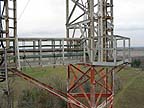
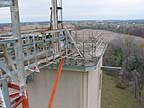
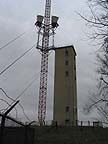
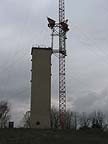
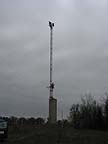
Common Language Location Identifier (CLLI): CTWBOHQ0010
Geolocation (GL) code: OH2380
Address: 10955 Knoxville Rd., Mechanicsburg (Clark County) OH 43044
Latitude: N40-00-29 (40.00806)
Longitude: W83-35-14 (-83.58722)
Elevation: 1310 ft. (399 M)
The principal structures at Catawba are a concrete "silo" tower, square in plan and 104 ft. (32 M) tall, and an adjacent 450 ft. (137 M) guyed steel-lattice tower with two pairs of horn-reflector antennas. A steel bridge, supporting waveguides which formerly carried microwave signals between the antennas and radio equipment in the concrete tower, links the two towers. The concrete building is typical of those built in the midwest during the early years of AT&T's microwave network. The guyed tower is fairly rare in AT&T practice, as most of the company's steel towers are of the self-supporting type.
The concrete tower at Catawba was built in late 1949 as a microwave relay station (an "auxiliary station" in AT&T terminology) between Springfield to the west and the Laveque Tower, a tall office building in downtown Columbus, about 32 miles to the east. The station was part of a route which carried network television programming from Dayton to Columbus. Two pairs of delay-lens antennas were mounted on the Catawba tower's roof. Initially, three radio channels using TE-2 microwave radio equipment were installed to carry television programming from Dayton to Columbus, the equipment was placed into service in October 1949, with one of the three channels arranged for reversible operation. By May 14, 1951 additional radio channels were installed to carry television signals from Columbus to Dayton and on to the nationwide TV network.
The TE-2 equipment was replaced with TD-2 type equipment by July 1953.
As the Long Lines network grew, AT&T constructed additional microwave routes to serve Columbus. The new routes did not terminate at the Laveque Tower, but rather at an Ohio Bell Telephone (now Ameritech) central office a few blocks away. During this network expansion, the Catawba route was changed so that it, too, terminated at the Ohio Bell building. Presumably, this was done in order to consolidate all of the city's microwave routes at a single destination.
Catawba's steel tower, horn-reflector antennas and waveguide bridge were probably constructed when the station's destination was changed. The antennas at the Ohio Bell central office were attached to a short tower on building's roof, at a height of about 270 ft. (82 M) above ground level - considerably lower than the Laveque Tower's antenna location. It's likely that Catawba's concrete tower was not tall enough to avoid interference from the terrain along the microwave path between the antennas, and that the new tower was erected to provide additional terrain clearance. The path profiles below illustrate how the terrain encroached on the path between Catawba's concrete tower and the rooftop tower in Columbus, and how the new, taller tower at Catawba provided an unobstructed path between the stations.
The use of horn-reflector antennas on the new tower, in place of the delay-lens antennas on the concrete tower, was in keeping with the Bell System's plans for improving its microwave network. The horn-reflector, developed several years after the delay lens, allowed a given route to carry more traffic by supporting dual polarizations (doubling the number of radio channels available) and simultaneous transmission in the 4, 6 and 11 GHz frequency bands. The delay-lens antenna operated with only one polarization, and only in the 4 GHz band.
As AT&T converted its network to fiber optics, Catawba was no longer needed and was shut down. The station was sold to American Tower Corporation, which offers space on the tower for lease to cellular telephone carriers and other wireless communications companies. American tower has produced an online site brochure describing the facility.
 |
 |
 |
 |
 |
Updated on August 11, 2003 at 01:08 by Albert LaFrance